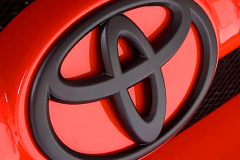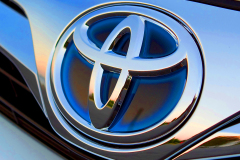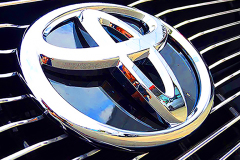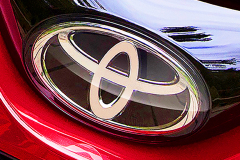Toyota
Toyota was founded by Kiichiro Toyoda in 1937 to create automobiles, as a spinoff from his father’s company Toyoda Industries. While still a department of Toyoda Industries, it created its first passenger cars in 1936, the Toyota AA sedan and Toyota AB cabriolet.
The family name Toyoda was changed to Toyota because it took eight brush strokes (a lucky number) to write in Japanese, and was visually simpler. It also prevented the company from being associated with old-fashioned farming since toyoda literally means “fertile rice paddies”.
From September 1947, Toyota’s small-sized vehicles were sold under the nickname “Toyopet”. When Toyota entered the US market in 1957 with the Toyopet Crown, the name was not well received due to connotations of toys and pets. The name was soon dropped for the US market, but continued in other markets until the mid-1960s.
By the early 1960s, the US had begun placing stiff import tariffs on certain vehicles. The so-called “chicken tax” of 1964 placed a 25% tax on imported light trucks. In response Toyota, Nissan and Honda began building plants in the US in the early 1980s.
One famous sportscar is the limited edition Toyota 2000GT (1967-1970), front-engine, rear-wheel-drive, two-seat, hardtop coupé grand tourer. The 2000GT design is widely considered a classic among 1960s gran turismos. The bodywork was inspired by the Jaguar E-type. A custom open-top version was built for the James Bond film “You Only Live Twice”. Other sportscars include the MR2 Spyder, Supra, Celica and Toyota 86.
Toyota SUVs and crossovers include the Matrix, FJ Cruiser, 4 Runner, Highlander, Landcruiser, RAV4 and Sequoia. Trucks include the Tacoma and Tundra. Vans include the Sienna and Previa.
Other sedans and compacts include the Avalon, Camry, Corolla and Yaris.
Toyota is the world’s market leader in sales of hybrid electric vehicles, and one of the largest companies to encourage the mass-market adoption of hybrid vehicles across the globe. Toyota is also a market leader in hydrogen fuel-cell vehicles.
The Toyota Prius, flagship of Toyota’s hybrid technology, is the world’s best-selling hybrid car. Other hybrids in Toyota’s lineup includes the Camry, Highlander, Avalon and Auris.
The RAV4 EV is a second generation, all-electric car, developed together with Tesla Motors. The RAV4 EV has a combined range of 103 miles and a combined fuel economy rating of 76 mpg. The Toyota iQ EV (intelligence quotient) is an all-electric, front-wheel-drive city car. The Toyota iQ EV has a combined range of 50 miles and a combined fuel economy rating of 121 mpg.
The Toyota Mirai (Japanese for “future”) is a mid-size hydrogen fuel cell car, one of the first such sedan-like vehicles to be sold commercially. The Mirai has a total range of 312 miles, with a combined city/highway fuel economy rating of 66 mpg.
Scion is a discontinued marque of Toyota that started in 2003. It was designed as an extension of Toyota’s efforts to appeal towards younger customers. The Scion brand primarily featured sports compact vehicles (primarily badge engineered from Toyota’s international models), a simplified “pure price” model. The Scion name, meaning the descendant of a family or heir, refers both to the brand’s cars and their owners.
Scion sales fell after the economic downturn and Toyota announced that it would shut down the brand in August 2016, with selected models to be re-branded as Toyota vehicles for the 2017 model year.
Lexus is the luxury vehicle division of Toyota, headquartered in Nagoya, Japan. Operational centers are located in Brussels, Belgium and the U.S. in Plano, Texas.
Its first car was the 1989 Lexus LS, full-size luxury sedan, designed to compete in the export market with international luxury brands such as Mercedes-Benz, BMW and Jaguar. The LS (Luxury Sedan) still serves as the flagship model of the division.
Lexus soon followed with sedan, coupé, convertible and SUV models. In 2005, a hybrid version of the RX crossover debuted and additional hybrid models later joined the division’s lineup.
Lexus launched its own F marque performance division in 2007 with the debut of the IS F sport sedan, followed by the LFA supercar in 2009.
Following a corporate reorganization from 2001 to 2005, Lexus began operation of its own design, engineering and manufacturing centers.
In 2005, Lexus become the first Japanese premium car marque to launch in its country of origin. The brand was also introduced in Southeast Asia, Latin America, Europe and other regions.
The Lexus brand has become Japan’s largest-selling make of premium cars with its largest market being the US.
The global Lexus lineup features sedans of different size classes, including the compact IS and HS models, mid-size ES and GS models, and the full-size LS. The 2-door coupe range consists of the RC and the LC. Former convertibles include the SC and IS C models. Sport-utility vehicles range in size from the compact NX and RX crossover, to the mid-size GX and the full-size LX. Hybrid models include the CT hatchback, HS sedan, and variants of the GS, LS, LC, IS, NX and RX. The F marque line formerly produced a variant of the IS and the LFA and currently produces a variant of the GS sedan and the RC coupe.
Lexus won the Rolex Sports Car Series Manufacturers’ Championship in 2006, 2007 and 2008.
On 30 March 2018, as an April Fool’s Day joke, Lexus premiered a fake partnership with” 23 and Me” during a spot on “Saturday Night Live”, for a pretend program that allows buyers to customize vehicles based on their DNA.
The Toyota Motor Co. is the sixth-largest company in the world by revenue and is the largest automotive manufacturer





